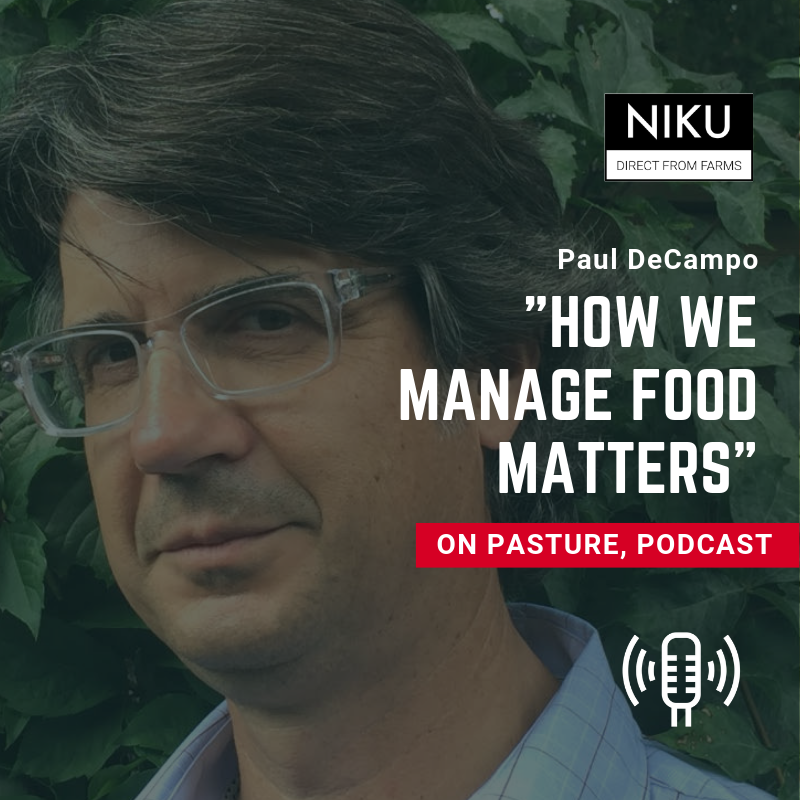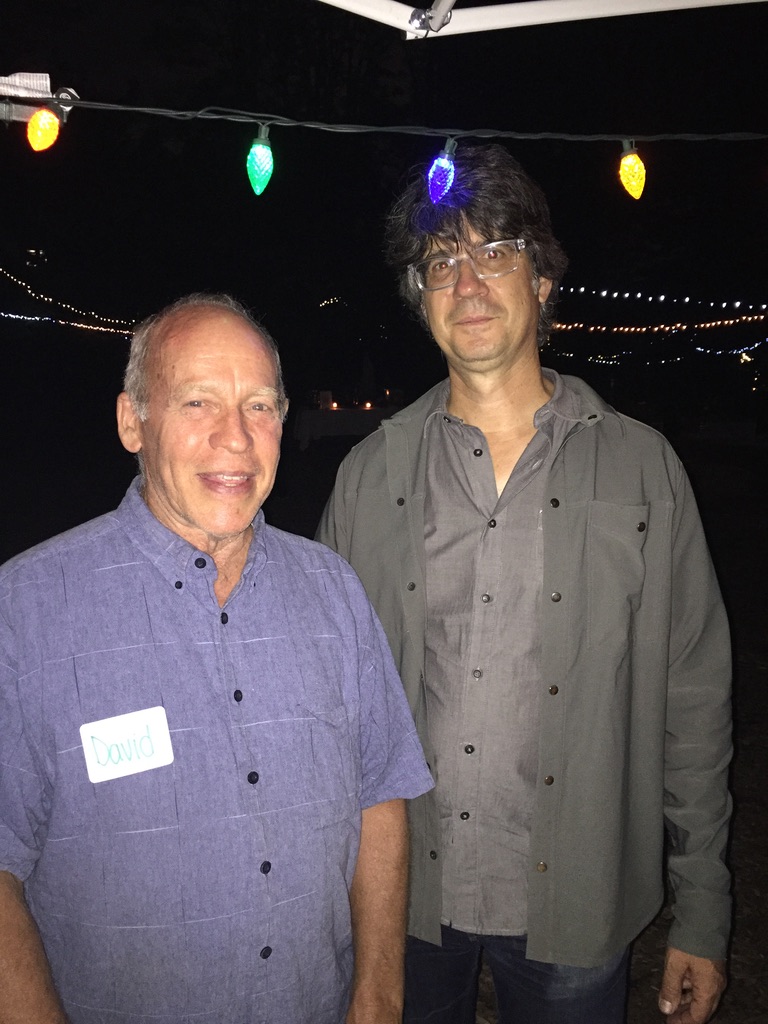Get $60 OFF throughout your first 2 boxes with code HOLIDAY60.
Offer ends in ::
Set your location to shop products local to you.
NIKU Farms
Thank you for your feedback!
If you requested further assistance, you’ll receive an email confirmation and we’ll follow up within 24 hours.
Got more questions? Start a new chat.
End chat
Are you sure you want to end the chat?
Cancel
Are you sure?
Your response has not been submitted. To process your request for further assistance, please hit the 'Back' button below, complete the form and submit your request.
Close Chat
This week, we sat down and discussed biodynamic agriculture, the Slow Food Movement, and food equity and education with Paul DeCampo, former director of the Toronto Slow Food chapter, director at Southbrook Winery, and current business developer and educator at George Brown College for International Spirits.
[Check out the podcast below to listen to the full interview!]
Our Food is not the Same as it Once Was
The food that you see on the table before you for every meal, is not the food it once was. For starters, things have gotten a lot more complicated. Most of our agriculture is mass produced on soils that take in large amounts of chemical fertilizer. Of all the food we do produce, most of it does not end up in our mouths, but used as fuel, animal feed, or wasted in long distribution lines before it gets to the grocery store. Yet, the biggest change our food has seen is that the best food for us (the food that was grown biodynamically, sustainably, and locally) is also the type of food many people can’t afford.
Paul

Passion for Food Starts Young
Paul’s passion for good food started during his childhood. He feels lucky to have grown up in a house where food was important and where, “we talked and got excited about food”. Both of his grandfathers were involved in the food industry as farmers and his father was in the produce business – Paul estimates that he probably trimmed about a half-million heads of iceberg lettuce by the time he was twelve years old.
How our Food Changed & The Beginnings of Organics and Biodynamic Agriculture
“The health of soil, plant, animal, and man is one and indivisible.” – Sir Albert Howard
Paul points out that all of our food was once “organic”. “All agriculture was organic until about the early 1900s”, Paul points out, “before we invented nitrogen-based fertilizers, as a by-product of the arms industry”.
The origin of organics came about in the 40s. Farmers had become dependent on nitrogen-rich fertilizers, but with the war effort in full swing, there wasn’t enough nitrogen to go around. At the same time, Sir Albert Howard, who many refer to as “the father of modern organics”, was in India, teaching about Western agricultural practices, when he found that the country could teach him more.
While working in India, Howard noticed the connection between healthy soil and the villages’ healthy populations, livestock, and crops. He noticed how Indian farmers would integrate animals into the growing system, to cycle nutrients back into the soil, and that they would use fallow periods in these systems. This was the origin of modern organics. Organic didn’t mean not using synthetics, but building organic matter into the soils for healthier plants, animals, and people.

Going back further, biodynamic agriculture is a movement developed in the 1920s by Rudolf Steiner, an Austrian philosopher. The concept treats animals, crops, and soil as a single system. The focus, like other organic approaches, puts emphasis on using manure and compost, but also avoiding artificial chemicals on soil and plants.
The three main biodynamic principles include:
1. Using herbal and compost “teas” to restore biological health
2. Integrating plants and animals in a cohesive fashion into the growing system.
3. Limiting off-farm inputs, by becoming less dependent on chemical and seed manufacturers, and developing your own resources on the farm.
How We Resisted the Change to Our Food: the Origins of the Slow Food Movement
With all of the changes to our agricultural practices, our food began to change throughout the mid-twentieth century. As a consequence of industrialization of the food industry, the Slow Food Movement began in the late 1980s.
“It’s important to recognize that there were periods of hunger, in the developed world in the last century. There’s a reason why mechanization and the application of science to agriculture happened. We have an obligation to feed people, and some of these methods are useful,” says Paul.
He offers canned tomatoes as an example. To offer a can of organic tomatoes on a retail shelf for a reasonable price, scale is important to making food available. Paul notes that while our food changed for the worse, it’s important to remember that the original transformation of the food system throughout the last century was originally done with good intentions.
The problem with this transformation, however, is that it has been detrimental to our food, nutrition, food economies, and for the people actually making our food. There is now a lack of transparency which has led to more additives in our food and a drop in the quality, as well. Speed and uniformity have taken over, in place of nutrition and flavour.
This is where Slow Food comes in. The movement originated in 1986 in Italy, when Carlo Petrini was among those who opposed the opening of a McDonald’s in Rome. The message of this resistance quickly spread, and in 2006, Paul became a director of one of Canada’s Slow Food chapters.
The Slow Food Movement’s motto is “Good, Clean, Fair”. Good, meaning following traditional practices and genetics (excluding GMOs, for example); clean, meaning that food is grown in a way that is beneficial and even regenerative for the environment; and fair, meaning that there is a fair return to farmers, as well as fair access to food. As Paul points out, many of the people who do the hardest work in the food industry, from the fields to the kitchen, get the least benefit from this system. In order to combat this, Slow Food focuses on distributing the benefits of the dollars that are spent on food more equitably to the people working in the food industry.
“How we manage food matters,” says Paul . “[as well as] the injustice of lack of access to food, both domestically and globally.” We produce far more calories per year than humans need to thrive. In fact, much of the excess grain we produce is turned into alcohol, both for fuel and consumption. It is also fed to animals, which is both inefficient and unhealthy for them and us. Ultimately, Paul says, “the problem isn’t producing more calories, it’s distributing the calories we have.”
It’s Not The Food Price, It’s the Economic System: why slow food is seen as elitist
Food movements often carry a reputation for being elitist. Paul says that the problem isn’t the food prices of better, healthier food, but that it’s current economic system’s unfair distribution of wealth that’s to blame.
“We have an economy that creates lots of wealth, but it’s increasingly concentrated into fewer and fewer hands,” says Paul. This unfair system has fed directly into the problem of urban hunger, which has created a frustrating tension between advocates for the urban poor, and proponents of the slow food movement. While Slow Food is fighting for better incomes for farmers and better share for rural economies, there are groups that see the movement as unfair to the poor.
This tension is not the fault of the food system, however. Rather, both groups can look to the same cause: the economy. Our current economic system has led to structural unemployment, among other issues, and doesn’t distribute the benefits of the economy as fairly as it should, says Paul.
How to Rebuild our Food System, and Food Access
There are solutions to this divide between people who are dealing with food insecurity and the Slow Food Movement. One organization trying to bridge the gap is FoodShare Toronto with its Good Food Program. This organization emphasizes shortening the connection between farmers and consumers, building food education programs, and distributing healthy produce at a fair price.
Shortening the link between consumers and farmers is ultimately the goal of Slow Food. The Good Food Program does this by controlling the distribution cost between farmers and consumers with volunteer work, allowing them to deliver boxes of healthy produce to people at a fair price.
Another part of Slow Food is food education. Paul says that cooking food from scratch is the most important thing we can do with the food system. If we want things local, we should cook from scratch. For example, while a can of soup may say it’s a product of Canada, we have no way to control whether all of the ingredients are actually produced here.
NIKU Farms
In the end, the Slow Food movement is striving to create equity for everyone, and that’s no easy task. But we can all do our part and contribute to a better, healthier future.
At NIKU Farms, we’re helping to support farmers by creating an online platform connecting people directly to ethically raised meat from local farms. The average farmer receives only 16 cents of every retail dollar. We provide a better return for our partners so they can make a living, ensuring that they make about three times as much as the national average.
We also want to make sure that buying locally sourced and ethically raised meat benefits our customers. By partnering with local farms and cutting out the middle-person, our customers are able to purchase better-quality meat at affordable prices and health benefits, with 100% transparency into where and how your meat is raised.
Check out our partner farms here, and be sure to follow us on Instagram and Facebook to hear more about our partner farms and other news!

when you subscribe to our mailing list.